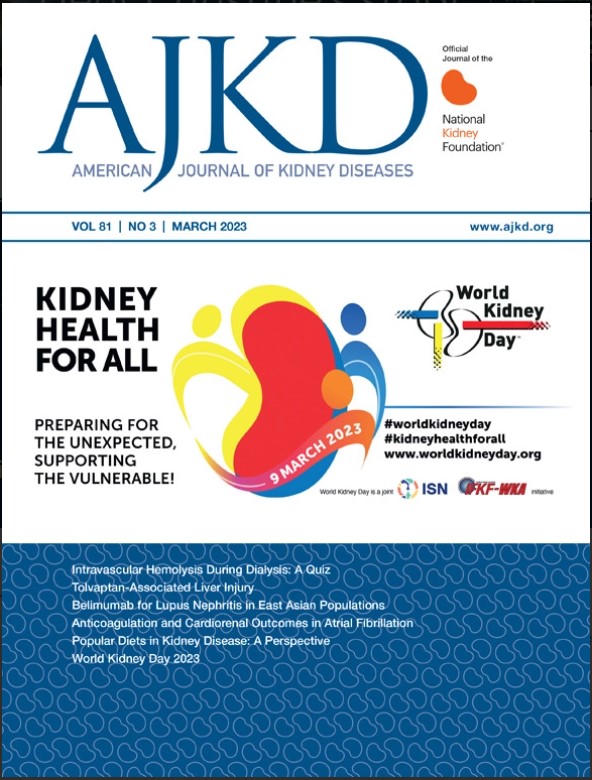通过加速度计测量的特定强度体育锻炼、遗传易感性和肾结石疾病风险:英国生物库的结果。
IF 9.4
1区 医学
Q1 UROLOGY & NEPHROLOGY
引用次数: 0
摘要
理由与目标:肾结石病(KSD)是发达国家和发展中国家的一个重要医疗问题,它与遗传风险因素有关。此外,人们还假设体育锻炼与 KSD 风险之间存在关联,但研究结果并不一致。本研究旨在调查体育锻炼强度与 KSD 发病率(考虑遗传风险)之间的关系:前瞻性队列研究:英国生物库研究(UK Biobank Study)的80,473名参与者:体力活动水平,包括总体力活动(TPA)、中高强度体力活动(MVPA)和轻度体力活动(LPA),使用加速度计进行测量,并使用机器学习模型进行量化。此外,还构建了 KSD 的多基因风险评分(PRS):使用第 10 版《国际疾病分类》和 KSD 手术的程序代码识别 KSD 患者:分析方法:采用 Fine and Gray 生存模型估算 KSD 发病与 TPA、MVPA、LPA 和 PRS(作为分类变量)之间的关系。在完全调整的模型中,使用限制性三次样条来检验潜在的非线性关联:在平均 6.19 年的随访期间,421 名参与者出现了 KSD。与最低四分位数的参与者相比,TPA、MVPA 和 LPA 最高四分位数的参与者的 KSD 调整后发病率较低:HRs(95% 置信区间)分别为 0.50 (0.44, 0.56)、0.57 (0.51, 0.64) 和 0.66 (0.59, 0.74)。在KSD遗传易感性较低和较高的参与者中,TPA、MVPA和LPA与较低的KSD风险相关:局限性:由于提供加速度测量数据的参与者可能更重视医疗保健,因此存在选择偏差:无论遗传风险如何,体育锻炼与 KSD 风险呈负相关。未来有必要开展大型研究,以确认和解释这些关联的内在机制。本文章由计算机程序翻译,如有差异,请以英文原文为准。

Intensity-Specific Physical Activity Measured by Accelerometer, Genetic Susceptibility, and the Risk of Kidney Stone Disease: Results From the UK Biobank
Rationale & Objective
Kidney stone disease (KSD), a significant health care problem within both developed and developing countries, has been associated with genetic risk factors. An association between physical activity and KSD risk also has been hypothesized, but studies have yielded inconsistent findings. This study investigated the association between the intensity of physical activity and the incidence of KSD accounting for genetic risk.
Study Design
Prospective cohort study.
Setting & Participants
A total of 80,473 participants from the UK Biobank Study.
Exposure
Physical activity levels, including total physical activity (TPA), moderate-to-vigorous intensity physical activity (MVPA), and light-intensity physical activity (LPA), were measured using accelerometers and quantified using a machine learning model. A polygenic risk score (PRS) for KSD was also constructed.
Outcome
Individuals with KSD were identified using the International Classification of Diseases, Tenth Revision (ICD-10), and procedure codes for KSD surgery.
Analytical Approach
A Fine and Gray survival model was used to estimate the associations of incident KSD with TPA, MVPA, LPA, and PRS (as categorical variables). Restricted cubic splines were used to examine potential nonlinear associations within the fully adjusted models.
Results
During an average follow-up of 6.19 years, 421 participants developed KSD. Participants in the highest quartiles of TPA, MVPA, and LPA had lower adjusted rates of KSD compared with those in the lowest quartiles: HR, 0.50 (95% CI, 0.44-0.56), 0.57 (95% CI, 0.51-0.64), and 0.66 (95% CI, 0.59-0.74), respectively. TPA, MVPA, and LPA were associated with a lower risk of KSD in participants with low and high genetic predisposition for KSD.
Limitations
Selection bias as participants who provided accelerometry data may have been more adherent to health care.
Conclusions
Physical activity was negatively associated with the risk of KSD, regardless of the genetic risk. Future large studies are warranted to confirm and explain the mechanisms underlying these associations.
Plain-Language Summary
The association between the intensity of physical activity (PA) and the incidence of kidney stone disease (KSD) after accounting for genetic risk is unclear. We conducted a comprehensive prospective cohort study utilizing participants from the UK Biobank to assess the intensity of PA using accelerometers. Our study findings indicated that greater total PA, moderate-to-vigorous-intensity PA, and light-intensity PA were each associated with a lower risk of KSD irrespective of an individual’s genetic risk. Our study informs the understanding of risk factors for KSD.
求助全文
通过发布文献求助,成功后即可免费获取论文全文。
去求助
来源期刊

American Journal of Kidney Diseases
医学-泌尿学与肾脏学
CiteScore
20.40
自引率
2.30%
发文量
732
审稿时长
3-8 weeks
期刊介绍:
The American Journal of Kidney Diseases (AJKD), the National Kidney Foundation's official journal, is globally recognized for its leadership in clinical nephrology content. Monthly, AJKD publishes original investigations on kidney diseases, hypertension, dialysis therapies, and kidney transplantation. Rigorous peer-review, statistical scrutiny, and a structured format characterize the publication process. Each issue includes case reports unveiling new diseases and potential therapeutic strategies.
 求助内容:
求助内容: 应助结果提醒方式:
应助结果提醒方式:


